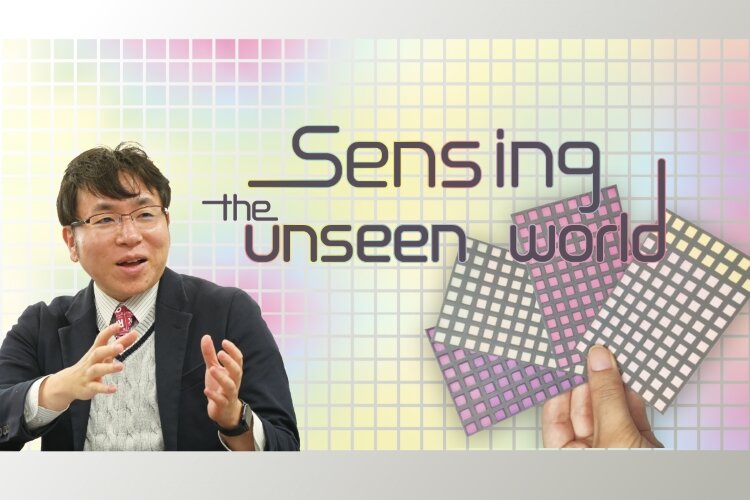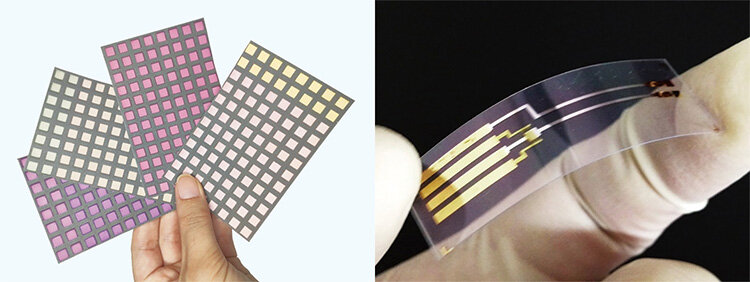Handy, low-cost sensors developed to detect chemical information of molecules, ions, virus for food analysis and health maintenance

In recent years, there has been increasing demand for the examination of molecules, ions, bacteria, viruses, and other things invisible to the naked eye that can influence humans both positively and negatively. Until now, identifying them has required bulky, expensive equipment and specialized knowledge. However, Associate Professor Tsuyoshi Minami of UTokyo-IIS is changing all that with the introduction of handy, low-cost sensors that rely on pigmentary change or electronic chips.
Pursuit of sensors that can make people happy
Associate Professor Tsuyoshi Minami says his ultimate goal is to develop sensors capable of bringing joy to people, particularly those that enable them to enjoy foods at their best in terms of flavor and tastiness, or in order to promote good health.
"As a gourmet, I appreciate aged beef, but excessive aging can spoil the meat," Minami explained, using the meat as an example to illustrate the applicability of his sensors. "Traditionally, we rely on our sense of smell to check for spoilage, a practice I consider outdated for the 21st century. My sensors can identify umami components such as glutamate, which gives beef its savory flavor, through pigmentary changes in reagents." Minami further noted that his sensors can be tailored to detect molecules related to physical and mental conditions, such as blood sugar and cortisol (a steroid hormone that can impact sleep, mood, and energy levels).
Acquiring diverse specialized knowledge
Before joining UTokyo-IIS in 2016, Minami acquired expertise in a different field, which might be unusual for a researcher. He is confident that his experience helped him develop cutting-edge sensors.
Hailing from a family with a scientific background, Minami joined his high school's chemistry club, where he investigated air pollution by using reagents to gauge the level of photochemical smog. "From my high school days, I wanted to see something invisible to the naked eye," Minami said. After entering Saitama University's undergraduate and master's programs to study sensors, he earned a doctoral degree from Tokyo Metropolitan University's Graduate School of Urban Environmental Sciences in 2011.
Minami then went to Bowling Green State University to learn about machine learning, which was not widely applied in the field of supramolecular chemistry at the time, to combine it with his expertise in sensing. After working as a postdoctoral research fellow and a research assistant professor at Bowling Green for three years, he decided to study how to make sensing devices from the viewpoint of supramolecular chemists. Minami returned to Japan in 2014 and landed a job as an assistant professor at Yamagata University to research organic electronics, a field far from his original area of chemistry.
"The field of sensors is cross-disciplinary," Minami said. "It is important to delve into a limited area, but it is also vital to broaden your horizons. Researching sensors requires knowledge not only in synthetic chemistry, but also in electronic devices and reagents, which I managed to acquire. So, I am confident that I have created my own research field."
Utilizing expertise on organic electronics, chemistry, AI
In his sensor research, Minami leverages his expertise in supramolecular chemistry, organic electronics, and machine learning. His research has a dual focus: to develop sensors with broader applications in society, and to target academic advancement.
The development for detecting substances such as nutrients involves the following steps: 1) Selecting a reagent capable of detecting the target molecule; 2) Placing the reagent in a standard inkjet printer tank; 3) Printing a sheet of paper with the reagent in a mesh pattern (sensor array: a group of sensors deployed in a specific geometric pattern); 4) Applying a sample containing target molecules to the sheet and waiting for any pigmentary changes. This method allows for sensing without the need for an electron microscope or analysis device, thus enabling individuals to perform tests at home without the need for specialized knowledge.
The academic pursuit, meanwhile, centers on supramolecular chemistry, a field inspired by the molecular recognition phenomena of living organisms, to create supramolecular materials (assembly of molecules held together by intermolecular interactions). It also involves the design and synthesis of molecules for developing materials, as well as developing electronic devices and chips, including organic transistor-based chemical sensor.
Minami is paying particular attention to the development of sensor devices capable of detecting physiologically active substances, which is crucial for understanding biological phenomena, or those that can detect environmental pollutants electrically and optically.
In conjunction with this research, he is developing technology to simultaneously analyze multiple samples for various target species. This technology is designed to analyze the various signaling responses collected by molecular sensor arrays through chemometrics (the science of extracting information from chemical systems by data-driven means), which is based on statistics and machine learning.

Aiming to develop a 'Doraemon gadget'
A source of inspiration for Minami is Doraemon, a globally renowned Japanese manga character hailing from the 22nd century who uses futuristic gadgets to help his friend. "I don't believe I can replicate Doraemon's gadgets precisely," Minami expressed with a smile. "However, creating one of Doraemon's gadgets might be feasible -- a pair of glasses that can identify only edible items when you're stranded on a desert island. My sensors may become capable of distinguishing between edible and non-edible items."
Although he faces many challenges in his future research, Minami is determined to accomplish his ambitious goals with the students and researchers who have joined his laboratory from around the world. "Ultimately, I aspire to develop a device capable of mimicking the functions within our bodies -- complex systems acquired through natural evolution," Minami said. "It would be exciting if our team could integrate a healing function (similar to capability derived from natural processes) into the device."
Structure and Utilization of Chemical Sensor Platform
Short Dialogue

Associate Professor Tochigi(→Breakthrough in atomic-scale exploration [UTokyo-IIS Bulletin Vol.13] ):
Unlocking the mysteries of the tiny world is fascinating. The most enjoyable moments for me are when I conduct experiments; that's when I encounter new things. Whenever I discover peculiar phenomena, I feel the urge to explain them. I feel unsatisfied otherwise.
Associate Professor Minami:
We learn in high school that the world is made up of molecules and ions. I feel happy when pigmentary changes occur in a sensor that I designed, because it shows the presence of molecules. I also get energized when my sensors do not work, because failures often provide useful insights and lead to new discoveries.
Tochigi:
That's right. New ideas emerge when I observe new phenomena with my own eyes. I then plan the next steps to elucidate what is causing crystal defects.
Reference
Xiaojun Lyu, Vahid Hamedpour, Yui Sasaki, Zhoujie Zhang, Tsuyoshi Minami, "96-Well Microtiter Plate Made of Paper: A Printed Chemosensor Array for Quantitative Detection of Saccharides", Analytical Chemistry (2021), DOI: 10.1021/acs.analchem.0c04291
Yui Sasaki, Yijing Zhang, Haonan Fan, Kohei Ohshiro, Qi Zhou, Wei Tang, Xiaojun Lyu, Tsuyoshi Minami, "Accurate cortisol detection in human saliva by an extended-gate-type organic transistor functionalized with a molecularly imprinted polymer", Sensors and Actuators B: Chemical (2023), DOI: 10.1016/j.snb.2023.133458
Related links
- Breakthrough in atomic-scale exploration [UTokyo-IIS Bulletin Vol.13]
- UTokyo-IIS Bulletin Vol. 13 is now available
